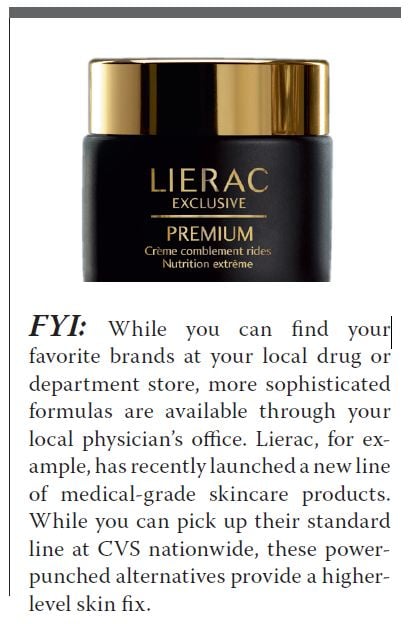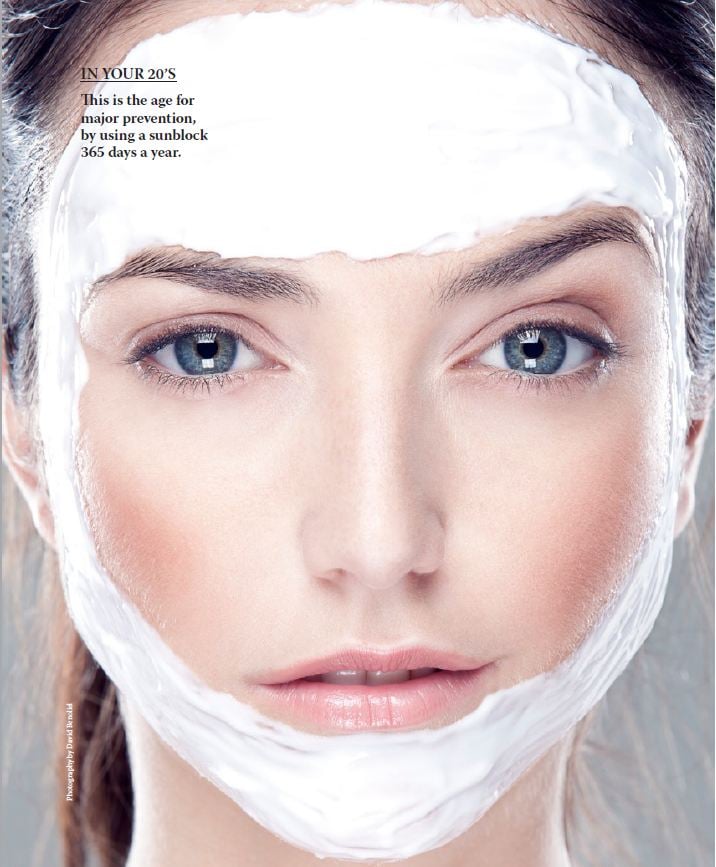A generational approach to skin care puts your best face forward at any age
![]()
![]()
t’s a harsh fact of life: Every day the clock ticks and we grow older. If you’ve been vigilant about sunscreen over the years and blessed with good genes, you probably look age-appropriate (or even younger than your years). But most likely your skin has started to show signs of premature wrinkling, the jumping off point to more lines, creases and splotches down the road.
But before you get glum, look on the bright side—today there’s a myriad of dermatological procedures that can ward off deeper wrinkles, fine lines, dark spots and sags for a few more years (at least until you’re ready to sh

“Over the last decade, we’ve seen newer, safer treatments that have minimal downtime with good results. Because of this, more people are doing things sooner,” says Edgar Fincher, MD, a dermatological and cosmetic surgeon in Beverly Hills, Calif. “You can’t stop the clock, but if you do preventative procedures, you’ll look better at an older age. Later on, it’s less likely you’ll have to do larger procedures, like surgery, or you may never have to do them at all.”
But how young should you start? Follow this anti-aging procedure guide to finding the best treatments for your age.
YOUR 20s
This is usually the decade where aging is the furthest thought from your mind. But the time is ripe for major prevention, which can be done by repeating this mantra over and over for the rest of your life (especially if you’re not doing it already): sunscreen, sunscreen, sunscreen!
Slathering your skin with an SPF30 or higher 365 days a year, limiting your sun exposure and using antioxidant moisturizers to fight damaging free radicals is the best way to prevent skin cancers and future lines, dark spots and wrinkles.
Still, forehead furrows and creases— indicative of genetics and facial gestures— can start to show up even at the tender age of 25 (sometimes even earlier). It’s worse if you are highly expressive or under a lot of stress. Some doctors will suggest a neurotoxin injection, like Botox or Dysport, which will calm the muscle down so their actions are less pronounced.
“There’s a limit at such a young age. Using Botox when you have no lines is very extreme. I inject people in their twenties only because they have genetic tendencies that will make the creasing worse,” says Dr. Fincher.
The good news is that, at this age, you may be putting off wrinkles without even realizing it. If you have acne—a common concern among women in their 20s—a prescription to Retin A will not only clear pimples, but also reverse sun damage and build new collagen, says Laura Skellchock, MD, a dermatologic and cosmetic surgeon in Boca Raton, Fla. The same goes if you opt for non-ablative laser treatments to minimize scarring: The increase in collagen production will thicken and firm skin, slowing down the aging process.
YOUR 30s
Around age 35, you may spot the first signs of aging—crow’s feet, lines and dark pigmented patches—and your focus turns to stopping them in their tracks. A good anti-aging regimen (see more below) coupled with daily sunscreen is a must, but there are other non-surgical procedures you can consider. While many doctors tread carefully with injecting neurotoxins in younger women—and even then, it’s mostly done on the forehead—in your mid-30s it’s more common to inject other upper face areas, like crow’s feet, frown creases or horizontal lines.

“There is a preventative side to Botox. I’m not advocating real young, but starting in your thirties, if you do it, it can mean less creasing and wrinkling than you would have if you didn’t do it,” says Joe Niamtu, DMD, a cosmetic facial surgeon in Richmond, Va. You may also notice that your skin’s perky glow is fading (blame a sluggish skin cell turnover, which clogs pores and dulls the skin’s surface), compounded by an uneven skin tone and a speckling of dark patches. Opt for a light chemical TCA peel or non-ablative laser resurfacing, like Fraxel, to increase cell turnover, reverse sun damage and zap away dark spots. You probably won’t need an aggressive CO2 laser to retexturize the skin (save this for your 50s), but these lighter procedures will boost collagen, so skin looks tight and smooth.
YOUR 40s
Early on in your forties, lines deepen, particularly around your mouth, cheeks and eyes. You’ll also begin to notice sagging and a loss of volume. “This is the age when a lot of women will consider trying a procedure. If you do some along the way, the less likely you’ll see the effects of aging,” says Dr. Fincher.
Dermal fillers are your best choice for filling in creases and plumping up skin. They range from temporary (like Restylane, Sculptra, Juvéderm and Radiesse) to permanent (your own fat). Weighing your options with your doctor, vocalizing what kind of results you’d like and doing your own research can be the deciding factors in determining the right filler.
Not quite ready for an injectable? Radiofrequency treatments, like Thermage, use heat technology to penetrate the deeper layers of tissue, stimulating collagen. It firms and contours, making sagging skin look taut. “I wouldn’t recommend this for someone younger with good collagen maintenance because it’s not going to add much. But when you’re older, it can be beneficial in building new collagen and tightening skin,” says Dr. Fincher.
YOUR 50s and Beyond
As you age, estrogen levels drop, and you’ll begin to notice bone loss, your brows descending and skin loosening. “Without enough ‘air in the balloon’, the skin falls. If you’ve kept up, you can avoid surgery with other augmentative procedures that support the underlying face structure,” says Dr. Skellchock.
To restore volume permanently, most women in this decade consider fat injections to lift sags and fill in the hollows. Another option, though more invasive, is silicone implants for the cheeks or chin. “They last forever, and don’t move, which fat can sometimes do. Plus, they’re reversible,” says Dr. Niamtu.
For wrinkles and a crepey skin texture, aggressive peels or laser resurfacing treatments are the top choices for smoothing them away. Most of all, be realistic. Talk to your doctor about the results and what works with your lifestyle. Says Dr. Niamtu: “Like anything, cosmetic rejuvenation has a lot to do with prevention. It’s key if you want to postpone the aging process for a while.”













